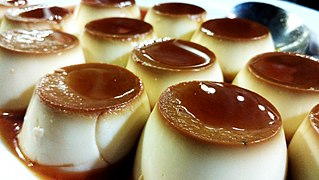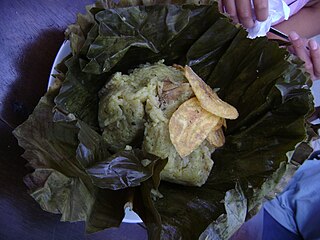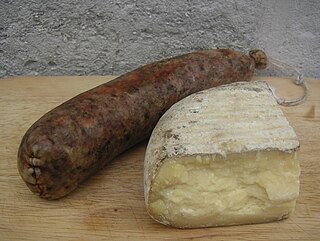
Ceviche, cebiche, sebiche, or seviche is a dish consisting of fish or shellfish marinated in citrus and seasonings. Different versions of ceviche are part of the culinary culture of various Spanish-American countries along the Pacific Ocean where each one is native: Chile, Colombia, Costa Rica, Ecuador, El Salvador, Guatemala, Honduras, Mexico, Nicaragua, Panama and Peru. In Peru it is considered a flagship dish and cultural heritage.

Crème caramel, flan, caramel pudding, condensed milk pudding or caramel custard is a custard dessert with a layer of clear caramel sauce.

An alfajor or alajú is a traditional confection typically made of flour, honey, and nuts. It is found in Argentina, Paraguay, the Philippines, Southern Brazil, Southern France, Spain, Uruguay, Peru, Ecuador, Colombia and Chile. The archetypal alfajor entered Iberia during the period of al-Andalus. It is produced in the form of a small cylinder and is sold either individually or in boxes containing several pieces.

Lambayeque is a city on the coast of northern Peru and capital of the homonymous district and province in the department of Lambayeque. It is located 4.7 km from the city of Chiclayo and 13 km from the Pacific Ocean. It is an important cultural and educational center of the department as it houses some of the most important museums in the country, such as the Royal Tombs Museum and the Brüning Museum. It was founded in 1553 under the name of San Pedro de Lambayeque by order of the Viceroy Conde de Nieva.
Peruvian cuisine reflects local practices and ingredients including influences mainly from the indigenous population, including the Inca, and cuisines brought by immigrants from Europe, Asia, and Africa. Without the familiar ingredients from their home countries, immigrants modified their traditional cuisines by using ingredients available in Peru.

Papas rellenas are the most popular type of croquettes in Latin American regions such as Peru, Ecuador, Bolivia, Mexico, Chile, Colombia, and the Caribbean. The first printed Latin American recipes date to the late 19th century, during a time when French cuisine was influencing the region.

Champús is a drink popular in Ecuador, Perú and southwest Colombia, made with maize, fruits such as lulo, pineapple, quince or guanábana, sweetened with panela and seasoned with cinnamon, cloves and orange tree leaves.

Chifa is Chinese Peruvian culinary tradition based on Cantonese elements fused with traditional Peruvian ingredients and traditions. The term is also used to refer to restaurants that serve the chifa cuisine.

Chicha morada is a beverage originated in the Andean regions of Perú but is currently consumed at a national level.

Arroz chaufa, also known as arroz de chaufa, is a fried rice dish from Peru. It is part of the Chinese Peruvian cuisine, which is called chifa.

Chifles, fried plantain chips, are a side dish, snack food, or finger food of Ecuador, Thailand and Peru.

Carapulcra, or carapulca, is an ancient Andean dish that has been prepared for centuries by both Quechua peoples and Aymara peoples. The original term for this dish in the Aymara language is qala phurk'a, which means a stew made with hot stones. In contemporary Peruvian cuisine and Bolivian cuisine, it is a stew of pork and papa seca, with peanuts, aji panca and mirasol peppers, garlic, and other spices like clove. In ancient times llama meat or alpaca meat would have been used, and some people still use these meats today. It is usually eaten with rice, boiled potatoes or yuca.

The juane is one of the main dishes of the cuisine of the Peruvian jungle and is widely consumed on June 24, the feast of St. John the Baptist, hence the name. It is known that after the arrival of the Spanish people to Incan lands, missionaries popularized the biblical account of the beheading of St. John. This dish's name could therefore be, more specifically, a reference to the head of St. John. It possibly originated in the city of Moyobamba.

Gastronomic Fair of Trujillo called Sabe a Peru is a gastronomy festival held in the Peruvian city of Trujillo. This festival has been held on 17 and 18 November 2012. It took place in Mall Aventura Plaza Trujillo. In 2012 the festival paid tribute to the "mochero chili" for being an indigenous product, Moche culture legacy. Its historical roots are attractive to encourage experiential tourism in ancestral plots of Trujillo.
Alfajor de Trujillo is a typical kind of alfajor from Trujillo, a Peruvian city. The alfajor de Trujillo is manufactured since old times and has several layers and it can be of different sizes and shapes as round or square. It is made mainly with products as flour, butter, eggs and milk, filled with milk candy, some pineapple sweet and in some cases peanuts, with cookies within its layers. The most famous company manufacturing this products in Trujillo is Dulcería Castañeda. It is one of the products presented in the Gastronomic Fair in Trujillo.

Jalea is a Peruvian cuisine dish consisting of fried fish, squid, and other seafood, originating in the northern region, specifically in the regions of Lambayeque and Piura, influenced by the Muchik.

Bienmesabe is a sweet Spanish dessert prepared with honey, egg yolk, and ground almonds as primary ingredients. Its consistency significantly varies depending upon preparation methods used. The dessert is also popular in the cuisine of the Canary Islands. It has been described as influenced by Moorish cuisine. Several variations of the dessert exist.

Menorcan cuisine refers to the typical food and drink of Menorca.

Causa limeña or simply causa, is a typical and widespread entrée of the Peruvian gastronomy which has a pre-Columbian origin.

Tallarín saltado is a Peruvian dish that is found in chifa cuisine. The name of the dish comes from the word "stir-fry" (saltear), in which the food is fried over high heat in small pieces. To make this dish, some cooked noodles, vegetables and portions of meat are sautéed to taste. The seasoning or dressing comes from Chinese spices and sesame oil.


















